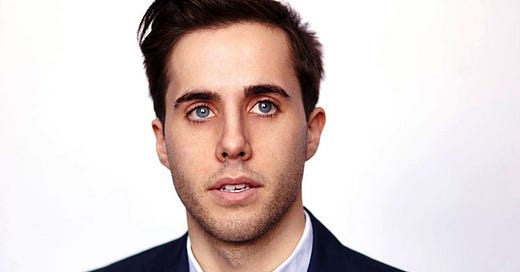Hello! Welcome to another edition of Inside The Newsroom, where today’s guest is… one of the smartest people to grace this podcast’s airways, Francesco Marconi! Francesco recently left the Wall Street Journal where he was R&D Chief to form his own company, Applied XL, in partnership with Brooklyn-based frontier technology center Newlab, which builds tools for journalists around the world using artificial intelligence. His new book, Newsmakers: Artificial Intelligence and the Future of Journalism, was published this year and Francesco’s giving away a handful of free copies to readers of Inside The Newsroom. So if you want a free book, email me at daniellevitt32@gmail.com and I’ll pass on the names of the first few! Up top is the podcast, down below is the post-game, including an updated job board. Enjoy! 🤓
Job Corner
The job board was updated last night with more than 350 active journalism jobs, internships and freelance gigs. New companies added include Netflix, Open Democracy, Politico Europe, and Rogers. Spread the word far and wide!
Who is Francesco Marconi?
Francesco was a student journalist just a few years ago and is now one of the most talented and knowledgable minds on the future of journalism. After completing a bachelor’s and master’s degree in economics in Portugal and Italy, respectively, Francesco moved to the U.S. to complete his master’s degree in journalism and business at the University of Missouri (MIZ!), and completed his post-graduate work at Columbia University and Harvard. He then scored a job with the Associated Press on its strategy team, before being hired by the Wall Street Journal as its Research and Development Chief. In addition to his many other positions and accolades, Francesco was recognized in 2018 among MediaShift’s top digital media innovators. Now Francesco runs his own company, Applied XL, part of New Lab, of which he is also SVP for Data and AI.

Like Me, Please
Before you read on, please like this edition of Inside The Newsroom by clicking the ❤️ up top. That way I’ll appear in clever algorithms and more people will be able to read. Cheers.
What is Artificial Intelligence and Machine Learning?
The never ending rise of power and influence of technology companies in our lives means we hear and read about terms such as artificial intelligence and machine learning seemingly every day. AI as we know it arguably started in the first half of the 20th century, just as computers were gaining steam. While AI and ML are closely linked and overlap in many ways, they are different.
Artificial intelligence is:
The overarching umbrella term for the simulation of human intelligence in machines programmed to think like humans and mimic our actions.
Whereas machine learning is:
The concept that a computer program can learn and adapt to new data without human interference. Machine learning is a field of artificial intelligence that keeps a computer’s algorithms current regardless of external changes. For example, autocorrect or self-driving cars.
Essentially, you need AI researchers to build the smart machines, and you need machine learning experts to make them super intelligent. You can’t have one without the other.
Newsmakers: What is the Future of Journalism?
Francesco answers the billion dollar question in his new book, Newsmakers: Artificial Intelligence and the Future of Journalism Paperback, which addresses journalism’s burning need to integrate AI and ML ten fold. Having been on both sides of the coin — R&D chief at The Wall Street Journal, manager of strategy and AI at the Associated Press, and now founder and chief data officer of Applied XL — Francesco believes journalism needs to continue to reflect and integrate the views of the audience into storytelling, whether that’s mining social media or using internal data to identify what people are talking about.
While that seems innocent and doable, we know it’s far easier said than done. We’ve talked plenty about The Inversion in this newsletter before — the real scenario that the majority of clicks, likes and comments on the internet are not made by humans but by click farms, where hundreds if not thousands of devices play and click on the same videos and posts, before moving onto the next one. Identifying what’s real and what’s a bot is incredibly difficult and not accessible to every news organization, which means a big part of the next decade will be the need for more collaborations between large and small news organizations, and the larger newspapers implementing M&A strategies similar to the likes of Google and Facebook.
Newspapers Are Now Technology Companies
Tech giants like Google and Facebook have for years bought smaller startups to integrate new technology into their platforms, and to ensure their existence and survival. According to this extremely trustworthy Wikipedia page, Alphabet (Google’s parent company) has acquired 234 companies, including the likes of YouTube in 2006 for $1.65 billion, Waze in 2013 for more than a billion dollars and has a pending deal for Fitbit that’s estimated to be around $2 billion. Facebook has also been extremely active, acquiring 83 companies according to its reliable Wikipedia page, including Instagram in 2012 for a bargain $1 billion, WhatsApp in 2014 for a whopping $19 billion and CrowdTangle in 2016 for an undisclosed amount. If the Google search engine or Facebook social media platform were to ever become extinct (more likely for Facebook), the two companies would still thrive because of all the pies they have fingers in. And now the same can be said of large news organizations.
The New York Times most recently bought Audm in March, an app that turns longform journalism into audio, part of a growing number of acquisitions according to its sturdy Wikipedia page. And The Boston Globe, with its partnership with New Lab, is another example of a media company investing in new tools to improve the storytelling experience. But let’s not get ahead of ourselves. Large organizations with large amounts of money are realistically the only outlets able to acquire assets and new technology, which is why the need for them to share their new technology with smaller news organizations has never been greater.
Democratizing Knowledge and Technology
Perhaps never in history has there been a greater gap in knowledge and innovation between large and smaller news organizations. It’s part of the reason that 33,000 journalists were laid off between 2017 and 2018, and according to a study by Pew Research, mid-market newspapers — those with between 100,000 and 249,999 daily circulation — experienced the largest cuts. The coronavirus pandemic has only poured more oxygen onto the fire, and Poynter has gathered a list of all the newsroom layoffs, furloughs and closures caused by the outbreak that’s updated daily.
So how do we plug this knowledge and innovation gap that’s widened? Part of it can be filled with more collaboration between newsrooms of different sizes. Whether it’s large-scale projects such as The Panama Papers, which was one of the largest joint journalism projects in history that exposed the corruption of the world’s biggest political leaders around the world, or the free distribution of tools such as TimelineJS, an awesome tool created by the Knight Lab at Northwestern University that allows for easily embeddable interactive timelines, there can never be too much collaboration. Here are a couple of sources to find out more about funding journalism projects.
Related podcasts…
#74 — Major Garrett (CBS News) on the difference between asking Barack Obama and Donald Trump questions in the White House press briefing room
#70 — Amy Webb (Future Today Institute) on the lack of government preparation for the coronavirus and the latest 2020 technology trends
Last week…
#76 — Betsy Sweet (U.S. Senate Candidate) from Maine on her race with Susan Collins, and a look at the history of campaign finance laws in the U.S.
#75 — Alex Schiffer (The Athletic) on the grind of making the jump from local to national journalism
… This week …
#78 — Mark Gamba (U.S. House Candidate) from Oregon on a 30-year career in photo journalism and the history of Oregon politics
… Next week
#Alex Crawford (Sky News) on her career as a war correspondent
#Burundi general election special 🇧🇮
Thanks for making it all the way to the bottom. Please like and share this edition of Inside The Newsroom by clicking the ❤️ below. That way I’ll appear in clever algorithms and more people will be able to read.
If you haven’t already, please consider subscribing to get a newsletter about a cool news topic in your inbox every time I publish (1-2 times a week). You can find me on Twitter at @DanielLevitt32 and email me corrections/feedback or even a guest you’d like me to get on the podcast at daniellevitt32@gmail.com.














Share this post